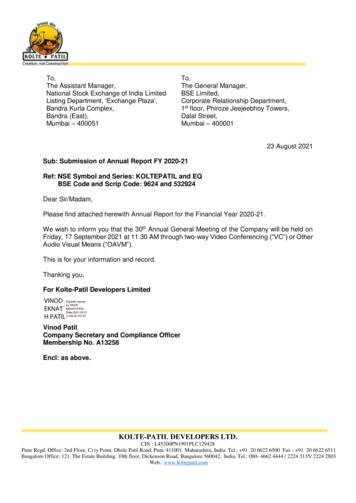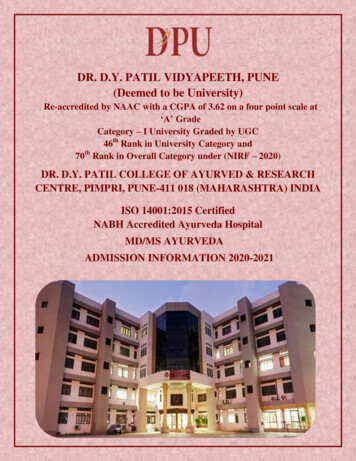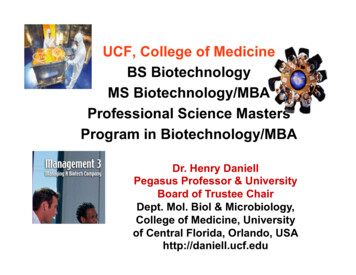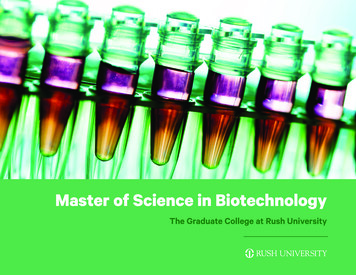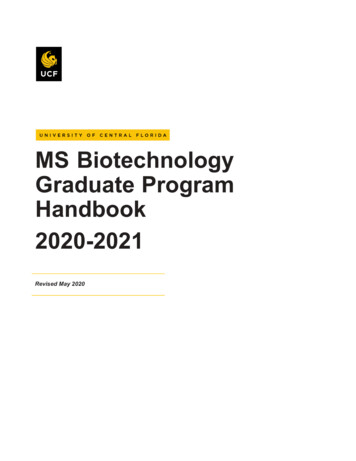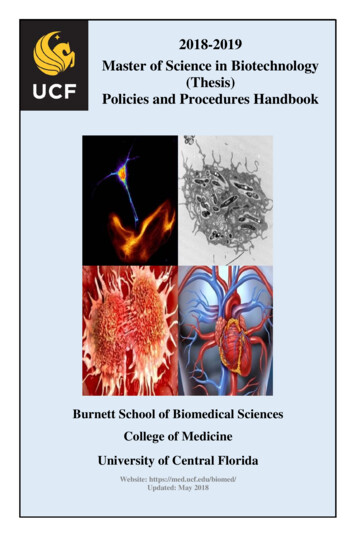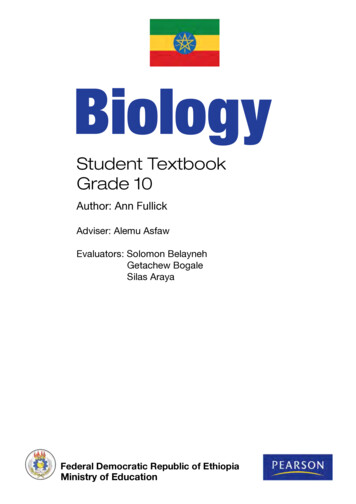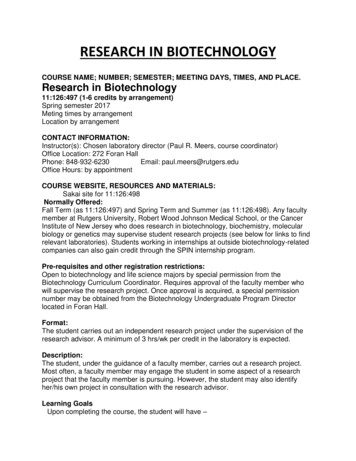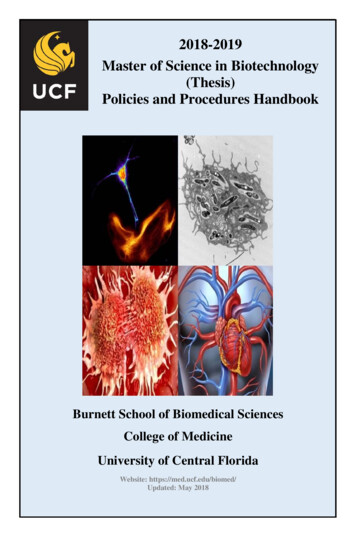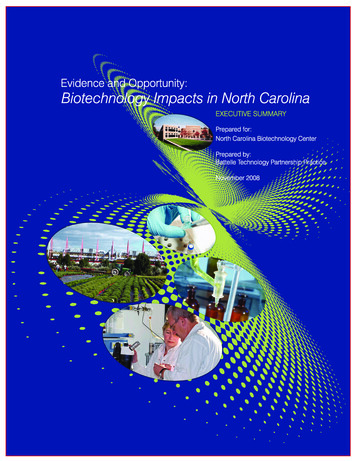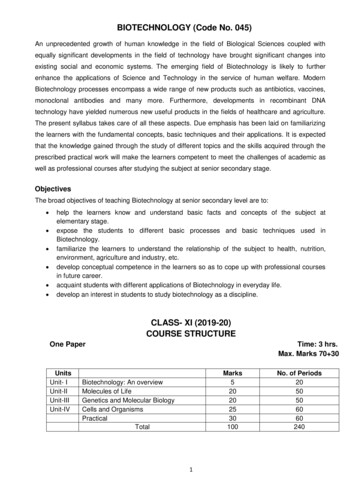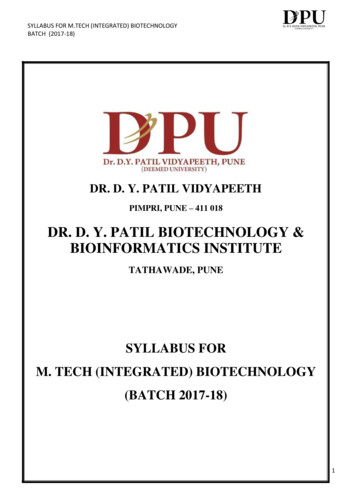
Transcription
SYLLABUS FOR M.TECH (INTEGRATED) BIOTECHNOLOGYBATCH (2017-18)DR. D. Y. PATIL VIDYAPEETHPIMPRI, PUNE – 411 018DR. D. Y. PATIL BIOTECHNOLOGY &BIOINFORMATICS INSTITUTETATHAWADE, PUNESYLLABUS FORM. TECH (INTEGRATED) BIOTECHNOLOGY(BATCH 2017-18)1
SYLLABUS FOR M.TECH (INTEGRATED) BIOTECHNOLOGYBATCH (2017-18)DR. D.Y. PATIL VIDYAPEETH, PUNEDR. D. Y. PATIL BIOTECHNOLOGY & BIOINFORMATICS INSTITUTE,TATHAWADE, PUNECOURSE STRUCTURE FOR M. TECH (INTEGRATED) BIOTECHNOLOGYCourse CodeBS 101BS 102BS 103SEMESTER ICourse NameL333T001P240Hr574Cr454PhysicsOrganic chemistryMathematicsIntroduction to Electronics &BT 10130254Instrumentation EngineeringIntroduction to Computers & ComputerBI 10130475OrganizationHU 101Communication Skills12033HU 102Disaster Management20022Total18 3123327BS - Basic Sciences, HU - Humanity, BT - Biotechnology, BI - BioinformaticsSEMESTER IICourse CodeCourse NameLTPHr CrBS 201Physical Chemistry31044BS 202Introduction to Bio-molecules30475BS 203Biostatistics31044BT 201Engineering Mechanics30254BI 201C Programming30475BS 204Environmental Sciences30254Total18 2123226SEMESTER IIICourse CodeCourse NameLTPHr CrBS 301Analytical Techniques30475BS 302Cell Biology30254BS 303Microbiology30475BS 304Genetics31265BS 305Mammalian Physiology31044BT 301Plant Physiology31044Total18 3123327SEMESTER IVCourse CodeCourse NameLTPHr CrBT 401Molecular Biology-I30475BT 402Metabolism31044BT 403Animal Tissue Cultures30254BT 404Plant Tissue Culture30254BT 405Immunology30254BI 301Concepts in Bioinformatics30475Total18 1501501502009502
SYLLABUS FOR M.TECH (INTEGRATED) BIOTECHNOLOGYBATCH (2017-18)SEMESTER VCourse CodeCourse NameLTPHrCrMarksBT 501Molecular Biology-II30475200100BT 502rDNA Technology31044BT 302Enzymology & Enzyme Technology30475200BT 503Basic Pharmacology and Toxicology31044100200BT 504Fermentation Technology30475BT 506 /Elective-I30475200BT 507Total1821636281000Elective I (BT 506 : Food Biotechnology / BT 507 : Environmental Biotechnology)SEMESTER VICourse CodeCourse NameLTPHrCrMarksBT 601Virology31044100Principles of Managements &HU 60130033100Entrepreneurial DevelopmentIntroduction to Molecular Modeling andBI 60530475200Chemo informaticsHU 602Bio safety and Bioethics & IPR31044100BT 602Genomics30254150BI 504 / BI 606Elective-II31265150/ BI 603Total18382925800Elective II (BI 504: Operating System / BI 603:Perl & Bioperl / BI 606:Computer Networking)SEMESTER VIICourse CodeCourse NameLTPHrCrMarksBT 701Biomembrane and Molecular Cell Signaling31044100BT 705Developmental Biology and Stem cells31044100Quality Control Management inHU 70131044100BiotechnologyBT 706Transcriptomics30475200BT 603Biochemical Engineering31483200BT 707 / BT708 / BT 709 / Elective-III30475200BT 710Total18382725900Elective III (BT 707: Metabolic Engineering / BT 708 : Marine Biotechnology / BT 709 :Agricultural Biotechnology)SEMESTER VIIICourse CodeCourse NameLTPHrCrMarksBT 801Protein Modeling and Drug Designing30475200BT 802Proteomics30254150BT 505Biomedical Engineering31044100BT 803Nanobiotechnology30254150Seminars in Biotechnology & Advances inBT 80431044100BiotechnologyBT 805 / BTElective – IV30475200710Total182123226900Elective III (BT 805: Clinical Research / BT 710 : Biopharmaceuticals)Semester IX & XResearch Project (10 months)50 Credits8003
SYLLABUS FOR M.TECH (INTEGRATED) BIOTECHNOLOGYBATCH (2017-18)COURSE STRUCTURE FOR M. TECH (INTEGRATED) BIOTECHNOLOGYCourse CodeBS 101BS 102BS 103SEMESTER ICourse NameL333T001P240Hr574Cr454PhysicsOrganic chemistryMathematicsIntroduction to Electronics &BT 10130254Instrumentation EngineeringIntroduction to Computers & ComputerBI 10130475OrganizationHU 101Communication Skills12033HU 102Disaster Management20022Total18 3123327BS - Basic Sciences, HU - Humanity, BT - Biotechnology, BI - BioinformaticsMarks15020010015020010010010004
SYLLABUS FOR M.TECH (INTEGRATED) BIOTECHNOLOGYBATCH (2017-18)TITLE OF THE COURSE: PHYSICSCOURSE CODE: BS-101MARKS: 150L T P Hr C3 0 2 5 4OBJECTIVEThe objective of this course is:To create general understanding regarding basic physical principles involved in livingsystems.To familiarize the student with basic concepts in physics as: classical optics used inmicroscopes and telescopes, thermometry and heat, mechanical, fluid and solid stateproperties.To familiarize students with concepts in digital electronics, lasers, sound waves, electricity.To introduce them to concepts in modern physics such as: production of X-ray, X-raycrystallography, quantum mechanics etc.LEARNING OUTCOMEAt the end of the course, the students will have sufficient scientific understanding of the basicconcepts in classical and modern physics, laser sources, concepts and laws applicable to quantummechanical particles. This would enable him to understand use of physical methods inunderstanding Biomolecular structure and interactionsPREREQUISITESThis is an introductory course. School level knowledge of physics is sufficient. There are noprerequisites.COURSE DESCRIPTIONSr.No.1TopicsOptics: InterferenceDiffraction &Polarization2Thermometry andHeat3Properties of Fluid:Surface Tension &ViscosityDetail syllabusIntroduction to optics, Principles of superposition,Constructuve & destructive Interference, Types ofInterference, Newton‟s rings.Diffraction- Types of diffraction, Diffraction grating,Rayleigh‟s criterion, Resolving power of Microscope andTelescope.Polarization of light waves, Polaroid, Optical activity.Principles of Thermometry, Temperature and it‟smeasurements, Platinum resistance Thermometer,Thermocouple and Thermistors, Modes of Heat Transfer.Surface Tension, Surface Energy, Angle of Contact,Capillarity action, Determination of Surface tension bycapillary rise method, Jaeger‟s method, Temperaturedependence of surface tension and its applications.Viscosity, Coefficient of viscosity, streamline and turbulentflow, Reynold‟s number, Stoke‟s law, Terminal velocity,No. ofLectures0805075
SYLLABUS FOR M.TECH (INTEGRATED) BIOTECHNOLOGYBATCH (2017-18)4Elasticity5Solids andSemiconductorDevices67Introduction to DigitalElectronicsLasers8Sound waves9Electricity10Modern Physics: Xrays, Crystallography,Introduction toQuantum MechanicsDetermination of „η‟ by falling sphere method.Stress and Strain, Hook‟s law, Stress-strain curve, Young‟smodulus, Determination of Young‟s modulus.Classification of Solids (Conductor, Semiconductor andInsulators), intrinsic and extrinsic semiconductors, PNJunction Diode, Zener Diode, Junction Transistors (CE,CBmode)Introduction to Binary mathematics, BCD numbers, Basiclogic gates, De-Morgan‟s TheoremProperties of Lasers, Production mechanism, Ruby Laser,Helium Neon Laser, applications of Lasers.Types of sound waves (Longitudinal and Transverse),Audible, Ultrasonic and Infrasonic waves, Beats, Dopplereffect, Applications of Ultrasonic waves.Heating effect of electric current, Joule‟s law, Transformers,Types of Transformers.Introduction to X-Rays : Introduction, Production of X-rays,X-Ray diffraction and its Applications.Introduction to crystal structure, Unit cell, seven crystalsystems.Plank‟s Quantum Theory, Properties of Photon, Photoelectriceffect, wave particle duality of radiation, de Broglie‟shypothesis, Heisenberg‟s Uncertainty principle.Total Lectures0305020303020745METHODOLOGYThe course will be covered through lectures supported by tutorials and practicals. In tutorials, apartfrom the discussion on the topics covered in lectures, assignments in the form of questions will begiven. Normally a students is expected to complete the assignment by himself, however if needed,difficulties will be discussed in the tutorial classes. There will be two class tests/ and surprise testconducted during the tutorial classes.EVALUATION SCHEME (THEORY)ExaminationDurationI Internal45 minutesII Internal45 minutesTeachers assessmentEnd Semester Exam2 hours 30 minutesTotalMarks15151060100BOOKS RECOMMENDED:1) Physics-David Haliday and Robert Resnik (Vol I and Vol II) [Wiley Eastern Pub] Perspectives ofModern Physics-Arthur Beiser [Mc Graw Hill]2) Fundamensls of optics-Jenkins [Mc Graw Hill] Optics –Ajoy Ghatak [Tata Mc Graw Hill]3) Digital Principles and Applications-Malvina and Leach [Mc Graw Hill]6
SYLLABUS FOR M.TECH (INTEGRATED) BIOTECHNOLOGYBATCH (2017-18)PRACTICAL IN PHYSICS(TWO HOURS PER WEEK)Marks 50The course will also have a practical component. The practical training would be in the area of optics,electronics, thermometry, calorimetry, conductivity, measurement of physical properties as: viscosity andsurface tension.LIST OF EXPERIMENTS1.Diffraction Grating: Use of diffraction grafting for determination of wavelength of spectrallining.2.Resolving Power: To determine the resolving power of Microscope or telescope.3.Diode Characteristics: Study of forward and reverse characteristics of Diode.Transistor Characteristics: Study of characteristics of Photocell.4.Band gap of semiconductor: Study of input and output characteristics of a transistor anddetermination of band gap of a semiconductor.5.Ultrasonic Interferometer: Determination of velocity of ultrasonic waves by ultrasonic6.Study of logic gates (OR, AND, NOT).7.Thermocouple: Study of variation of thermo emf (electromotive force) with temperature.8.Surface Tension: Determination of the surface tension of a given solution.11.Viscosity: Determination the coefficient of viscosity by Stoke‟s method and its practicalapplication.12.Joule‟s Law: Determine of Joule‟s constant.13.Determination of wavelength of monochromatic light by Newton‟s rings experiments.14.Thermal Conductivity: Determination of coefficient of thermal conductivity of givenspecimen.EVALUATION SCHEME PRACTICAL TRAININGExaminationMinor test 1Continuous AssessmentMajor test at the end of semesterTotalDuration1 hour3 hoursMarks151025507
SYLLABUS FOR M.TECH (INTEGRATED) BIOTECHNOLOGYBATCH (2017-18)TITLE OF THE COURSE: ORGANIC CHEMISTRYCOURSE CODE: BS 102MARKS: 200L T P Hr C3 04 7 5OBJECTIVE OF THE COURSE:The objective of the course is:To familiarize the students with basic concepts of organic chemistry.To familiarize the students with structures of organic molecules as: alkanes, alkenes, alkynes,aliphatic and aromatic moleculesTo introduce them to interactions amongst organic compoundsLEARNING OUTCOME:At the end of this course student should be able to understand basic principles of organic chemistry anddevelop skills in handling organic molecules. This is essential for undertaking practical training inBiochemistry and genetic engineering at the later stage.PREREQUISITES:This is an introductory course. There are no prerequisites for the course.COURSE DESCRIPTIONSr.TopicNo1Introduction to organicchemistry2Organic compounds3Stereochemistry4Chemistry of cyclic aliphaticcarbons5Chemistry of heterocycliccompoundsChemistry of aromaticcompounds67Reaction mechanismsTotal Number of lecturesDescriptionHrsFunctional groups2Chemistry of alkanes, alkenes, alkynes (Comparativestudy)Stereo isomers, Enantiomers, Chiral centers/ Opticalactivity, Geometric isomersMeso- isomers, Conformational isomersNomenclature and preparation,Reactions of small ring compounds, (cyclopropaneand cyclobutane), Baeyers Strength Theory,Stereochemistry of Cyclic Aliphatic compoundsFuran, Pyrrole, Thiophene, Purines, Pyrmidines(Nucleic acids), Quinoline, IsoquinolineStructure of Aromatic compounds (Benzene and itsderivatives), Aromatic Characters: The Huckel rule (4N 2)5Nucleophilic SN1, SN2 , Electrophilic E1 and E2 )5448888METHODOLOGYThe course would be taught through lectures, demonstrations and practical classes.8
SYLLABUS FOR M.TECH (INTEGRATED) BIOTECHNOLOGYBATCH (2017-18)EVALUATION SCHEME (THEORY)ExaminationDurationI Internal45 minutesII Internal45 minutesTeachers assessmentEnd Semester Exam2 hours 30 minutesTotalMarks15151060100BOOKS RECOMMENDED:thOrganic Chemistry (6 Edition, 1992)- Robert Thornton Morrison and Robert Neilson Boyd(Prentice Hall)thOrganic Chemistry Vol. I and II and III by I. L Finnar. 5 Edition Pearson PublicationsPRACTICAL IN ORGANIC CHEMISTRY(4 Hrs. PER WEEK)MARKS 100LIST OF EXPERIMENTS:1. 10 Quantitative analysis, 5 organic and inorganic mixtures2. Quantitative analysis:Estimation of aniline, acetone, and aspirinMolecular weight of monobasic/dibasic acids.3. Preparation of orange dyestuff (Sagand III)4. Preparation of p-nitroacetanilide from actanilide5. Preparation of acetnilide from aniline6. Preparation 2,4 DNP derivatives2 7. Estimation of Cu from brass8. Estimation of %q of NH4Cl BaSO4 grarimetric analysis9. Preparation of Std. K2Cr2O7 solution and estimation of Fe (II) and Fe(III) from a given mixture ofFe(II) and Fe(III) using external indicators.EVALUATION SCHEME PRACTICAL TRAININGExaminationMinor test 1Continuous AssessmentMajor test at the end of semesterTotalDuration1 hour3 hoursMarks3020501009
SYLLABUS FOR M.TECH (INTEGRATED) BIOTECHNOLOGYBATCH (2017-18)TITLE OF THE COURSE: MATHEMATICSCOURSE CODE: BS-103MARKS: 100L T P Hr C3 1 0 4 4OBJECTIVEThe objective of the course is to familiarize the student with basic concepts in mathematics.LEARNING OUTCOMEAt the end of the course, the students will have sufficient understanding of different mathematicsand statistical tools used in Biotechnology. This knowledge would be applicable in differentindustriesPREREQUISITESStudents should be familiar with school level mathematics to take up this course. In case they do nothave mathematics at the 10 2 level they should have cleared the core mathematics in the firstsemester.COURSE DESCRIPTIONSr.TopicsNo.1Algebra :1.1 Logarithms1.1.1 Definition of Logarithm (Natural and common logarithm1.1.2 Laws of Logarithm.1.2 Binomial Theorem:1.2.1 Definition of factorial notation, peronntation & combinations.1.2.2 Binomial Theorem for positive index.1.2.3 General term, middle term1.2.4 Binomial theorem for any index1.2.5 Binomial Theorem for Approximation.2Trigonometry :2.1 Trigonometric Rations (t-ratios)2.1.1 t-ratios of any angle, Relation between t-ratios, Fundamental identities.2.1.2 Relation between degree & radian, T-ratios of std. angles.2.1.3 Quadrants sign of T-ratios in various quadrants, T-ratios of negative angles.2.2 T-ratios of Allied, Compound, Multiple and Submultiples angles.2.2.1 T-ratios of Allied angles.2.2.2 T-ratios compound angles.2.2.3 T-ratios of multiple & sub-multiple angles.2.2.4 Factorization formulae2.2.5 Defactorization formulae.2.3 Inverse Trigonometric Functions.2.3.1 Definition of Inverse t-functions.2.3.2 Principle value of inverse t-functions.LecturesRequired020403080210
SYLLABUS FOR M.TECH (INTEGRATED) BIOTECHNOLOGYBATCH (2017-18)3456Function and Limit3.1 Function :3.1.1 Definitions of variable, constant, intervals such as open, closed, semi-open etc.3.1.2 Definitions of function, value of function, domain & range of a function.3.2 Limits :3.2.1 Concepts and definition of Limit.3.2.2 Limits of algebraic functions.3.2.3 Limits of trigonometric functions.3.2.4 Limits of exponential functions.3.2.5 Limits of logarithmic function.Derivatives4.1 Derivatives :4.1.1 Definition of Derivatives, notations.4.1.2 Rules of Derivatives (without proof)4.1.3 Derivatives of composite functions.4.1.4 Derivatives of Inverse trigonometric function by substitution method.4.1.5 Derivatives of Implicit functions.4.1.6 Logarithmic differentiation.4.1.7 Second order differentiation.4.2 Application of Derivatives4.2.1 Geometrical meaning of the derivatives.4.2.2 Equations of Tangent & normal to the given curve.4.2.3 Maxima & Minima.5.1. Integration :5.1.1 Definition of integration, Integration of Standard function; Rules of Integration.5.1.2 Integration of rationale functions; Trigonometric functions to determineconstant of Integration,5.2. Definite Integration:5.2.1 Definition of Definite integral, definite.5.2.2 Definite integral with simple problems.5.3. Application of Definite Integrals5.3.1 Area under the curves.5.3.2 Area between two curves.Differential Equation (D.E.)6.1. Definition of D.E., order & degree of D.E., formation of D.E for functioncontaining single constant.6.2 Solution of D.E. of first order & first degree such as:i) Variable separable type.ii) reducible to variable separable formiii) Exact D.E.iv) Linear D.Ev) Bernoulli‟s D.E.Total Lectures02060604030202044811
SYLLABUS FOR M.TECH (INTEGRATED) BIOTECHNOLOGYBATCH (2017-18)METHODOLOGYThe course will be covered through lectures supported by tutorials. In tutorials difficulties wouldbe solved. Problems would be given. Students would be given assignments in the form ofquestions. There will be two class tests/ and surprise test conducted during the tutorial classes.EVALUATION SCHEME (THEORY)ExaminationI InternalII InternalTeachers assessmentEnd Semester ExamTotalDuration45 minutes45 minutes2 hours 30 minutesMarks15151060100BOOKS RECOMMENDED:1) Mathematics for Biological Science by Jagdish Arya & Ladner.1979. Prentice Hall2) Numerical methods by E. Balguruswamy. 1999. Tata Mc Graw Hill Publications Pvt Ltd.3) Higher Engineering Mathematics B. S. Grewal, Khana Publication, New Delhi. 20034) Applied Mathematics P. N. Wartikar, Pune Vidaypeeth, Griha Prakashan, Pune5) Introductory Methods of Numerical analysis, S. S. Sastry, Prentice Hall of India, New Delhi.2005.TITLE OF THE COURSE: INTRODUCTION TO ELECTRONICS ANDINSTRUMENTATION ENGINEERINGCOURSE CODE: BT 101L TMARKS: 1003 0P Hr C25 4OBJECTIVE OF THE COURSE:Objective of the course is to familiarize students with the basic concepts of electronic engineering andelectronics engineering.This knowledge would help them in applying them in various biological techniques. Also theKnowledge of this subject will form a profound base for the instrumentation used in various advancedcourses of Biotechnology and Bioinformatics.LEARNING OUTCOMEAt the end of this course student should be able to understand the engineering electronics andinstruments.PREREQUISITESSince the course is very basic in nature, knowledge of physics and mathematics is required12
SYLLABUS FOR M.TECH (INTEGRATED) BIOTECHNOLOGYBATCH (2017-18)COURSE uction toElectronicsElectronic SignalsElectronic devices4Electronic circuits5Digital electronics6Microprocessor7Interfacing peripherals A to D converters, DAC, Resolution, speed, typesand n to instrumentation and definitionsSensing elementsTypes of sensors, electrodes and transducersElectrodes:Electrolyte interface, Sensing elements, Detectors, Signalconducting circuits, circuit models, suitability of electrode11234TopicHistory and Scope ofElectronicsCharacteristics of electrical SignalsInput & output relations, Simple electronics devices: Resistors,Capacitors, Inductors, Bias voltage.Simple circuits for amplification, power supplies and for waveshaping .Amplification: Concept of amplification, type ofamplifiers, OP-Amp and its characteristics, simple applications(Adder, substracter, integrator, differentiator), and filters.Number systems, binary codes, Boolean algebra, arithmeticoperations, logic functions, combinational and sequential logic,different OR, AND, NOR, NAND, EXOR gates, flip flops,registers and counters.Introduction to Microcomputer and Microprocessor and blockdiagram, CPU and ALU, Timing and control unit and Blockdiagrams instruction and data formats.potentials, circuit models, external and internal electrodes, pH,pO2 and pcO2 electrodes, connectivity.TransducersDefinitions, types, displacement pressure, temperature, vibration,ultrasound etc, calibration, sensitivity and resolution, Flowtransducers & Rota meter, venturi, orifice PlateTotal Number of Lectures1268844114645METHODOLOGYThe course would be taught through lectures, demonstrations and practicals.EVALUATION SCHEME (THEORY)ExaminationDurationI Internal45 minutesII Internal45 minutesTeachers assessmentEnd Semester Exam2 hours 30 minutesMarks1515106013
SYLLABUS FOR M.TECH (INTEGRATED) BIOTECHNOLOGYBATCH (2017-18)Total100BOOKS RECOMMENDED:rd1. Digital Electronics by R. K. Jain Jain, Tata Mc Graw Hill, 3 Edition, 2003.th2. Grob‟s Basic Electronics – Mitchel E. Schultz., Tata McGraw Hill, 10 Edition 2006.st3. Principals of electronics By V. K. Mehta , S. Chand Publisher , 1 Edition , 2010.4. Op Amps and linear integrated circuits By Ramakant Gaikwad, McGraw –Hill publishingthcompany limited, 4 Edition, 2002.rd5. Integrated Electronics By Millman and Halkias. Mcgraw-Hill, 3 Edition 1972 .rd6. The Z 80 Microprocessor By Ramesh Gaonkar,. Penram Publisher , 3 Edition, 1988.7. A course in electrical and electronic measurements and instrumentation by A. K. Sawhney,Puneet Sawhney, Rai publisher, 1996.PRACTICALS IN BASIC CONCEPTS IN ELECTRONICS AND INSTRUMENTATIONENGINEERING(2 Hrs. PER WEEK)MARKS 50COURSE DESCRIPTIONSr.No.Name of the Practical1.2.3.4.5.6.7.8.Time (Hrs.)Study of diode characteristicsStudy of operational Amplification 741 i) Inverting Amplifier ii) Noninverting amplifierStudy of operational Amplification 741 i) Inverting Amplifier ii) Noninverting amplifierStudy of Ph meter circuits & workingStudy of Ph electrodes & role of electrolytesStudy of Conductivity meter, circuits & workingStudy of Conductivity meter electrodes & functionsPressure development & vibration DVPT44444444EVALUATION SCHEME PRACTICAL TRAININGExaminationMinor test 1Continuous AssessmentMajor test at the end of semesterTotalDuration1 hour2.5 hoursMarks1505305014
SYLLABUS FOR M.TECH (INTEGRATED) BIOTECHNOLOGYBATCH (2017-18)TITLE OF THE COURSE: INTRODUCTION TOCOMPUTERS AND COMPUTERORGANIZATIONCOURSE CODE: BI 101MARKS: 150L T P Hr C3 12 6 5OBJECTIVE OF THE COURSE:The objective of the course isTo familiarize the students with computers and programming concepts.To introduce basic concepts in: hardware, software and its implementation.To introduce concepts of Networking, World Wide Web (Internet), Telnet, FTP, Etc.Programming module is intended to familiarize them with computer logic and solution of realworld problems using computers.LEARNING OUTCOMEAt the end of this course student would be able to understand basic principles of Computing,Networking and Programming.PREREQUISITESThe course is of introductory nature and there are no prerequisites for the course.COURSE DESCRIPTIONSr. No.TopicDescriptionHrs1Basic Organization ofComputers32Hardware3Software4Types of Computer5Data representation inComputersBinary ArithmeticIntroduction to Computer, historical background, Blockdiagram of a Computer, parts of Computer, theirintegration and function .Computer hardware, different types of I/O devices,motherboard, BIOS, Primary and Secondary Memory,different types of Printers, Storage Media, their sizesand use. Computer booting, loading operating system(OS) and execution. execution cycle (fetch and execute)Introduction to software, Application software(Packaged & Customized) and System Software (OS &Utilities). Complier & Interpreter, software loading andexecution, Task management by OS for ApplicationSoftware.Difference between Super Computer, Mini Computerand a Micro Computer and their applications.Introduction to Binary, Octal and Hexadecimal NumberSystemBasic Binary Arithmetic i.e. Addition, Subtraction,65422415
SYLLABUS FOR M.TECH (INTEGRATED) BIOTECHNOLOGYBATCH (2017-18)7891011121314Multiplication, Division, Compliments, Subtraction bymeans of 2‟s Compliment, Logical operations on Binary(AND, OR, NOT)Transforming Data intoDistinction between data and information theirInformationrepresented in computers.Operating System &OS, tasks performed by OS , Introduction to DOS,InterfaceWindows and Linux/UNIXNetworking Fundamentals Computer networks (n/w), various terms associated withnetworks, topologies for n/w, different mediums,hardware and technologies associated with n/w, n/wprotocols, introduction OSI layers, TCP/IP stack,services provided by TCP, IP AddressingClient Server Architecture Introduction to client, server, client-server architectureLAN/WAN/MAN/CANIntroduction to LAN/WAN/MAN and CAN, and theiruse. Different technologies used to implement them.Telnet, FTPHistory and use of Telnet based on UNIX terminals.FTP and its use. TFTP. Case study how to setup Telnetand FTP servers on LINUXInternet, WWW, HTMLInternet, DNS and name resolution. History of Internet.IP Addressing scheme and its relation to the Internet.Basic HTML tagsIntroduction to C andData types, Decision control, Loop control, CaseProgramming in highcontrol, Functions, Arrays and Stringslevel languageTotal Number of Lectures1251234846METHODOLOGYThe course would be taught through lectures, demonstrations and practical classes.EVALUATION SCHEME (THEORY)ExaminationI InternalII InternalTeachers assessmentEnd Semester ExamTotalDuration45 minutes45 minutes2 hours 30 minutesMarks15151060100BOOKS RECOMMENDED:Introduction to Computers by NortonFundamentals of Computers by Raja RamanComputers Fundamentals by SinhaIntroduction to Computers by Subramanian.16
SYLLABUS FOR M.TECH (INTEGRATED) BIOTECHNOLOGYBATCH (2017-18)PRACTICAL IN INTRODUCTION TO COMPUTERS AND COMPUTER ORGANIZATION(2 Hrs. PER WEEK)MARKS: 1001. Introduction to various components of a computer.2. Assignments on Microsoft Word3. Assignments on Microsoft Power Point4. Assignments on Microsoft Excel5. Assignments on Microsoft Access6. Learning the MS-DOS commands7. Creating web pages in HTML (Basic formatting tags, style attribute, adding image, Lists)8. Creating web pages in HTML (Table, Hyperlink to text and image, frames)9. Basic C programs (5 programs)10. C programs on Decision control (5 programs), Loop control (5 programs), Function (3 programs),Arrays (2 programs) and String (2 programs).17
SYLLABUS FOR M.TECH (INTEGRATED) BIOTECHNOLOGYBATCH (2017-18)TITLE OF THE COURSE: COMMUNICATION SKILLSCOURSE CODE: HU-101MARKS: 100L T P Hr C1 20 0 0OBJECTIVE:The objective of this course is:To develop communication skills amongst students,To familiarize students with communication elements,To acquaint them with the Scientific reading , Writing & Presentation skills.To familiarize students with concepts in plagiarism.LEARNING OUTCOME:At the end of the course, the students will be able to use different forms of communication, producegood document in science and avoid plagiarism of any form.PREREQUISITES:This is an introductory course and there are no prerequisites.COURSE DESCRIPTION :Sr.TopicsDetail syllabusNo.1Introduction toElements, definitions, scope of communication andcommunicationcommunication as part of science2CommunicationVerbal and nonverbal communications.elementsPrinciples of effective communication, Oral presentations,Barriers to communications, Use of good English:Introduction to English Grammar: parts of speech, use ofarticles & prepositions, use of correct tense, spellings etc.3Scientific reading,Introduction to scientific reports and writings?writing & presentation Compilation of experimental data, Communication methodsin science, Use of good English in science, Examples ofScientific and Unscientific writing.Process of Scientific writing: thinking, planning, rough draftsand revising context.Different styles of scientific writing APA, MLA or Chicago.Writing papers, reviews and Bibliography4PlagiarismIntroduction to PlagiarismExamples of PlagiarismTotal LecturesNo. ofLectures0202080416METHODOLOGYThe course will be covered through lectures supported by tutorials. During tutorials, students would18
SYLLABUS FOR M.TECH (INTEGRATED) BIOTECHNOLOGYBATCH (2017-18)be made to present scientific and nonscientific data/information using different communicationskills. They would be corrected as and when needed and taught how to improve their skills inreading, writing and data presentation.EVALUATION SCHEME (THEORY)ExaminationDurationI Internal45 minutesII Internal45 minutesTeachers assessmentEnd Semester Exam2 hours 30 minutesTotalMarks15151060100BOOKS RECOMMENDED:Technical Writing and Professional Communication- Thomas Huckin and Lesle Oleson LondonWilliam Collins and Sons.Business English and Communication- By Lyn Clark and Zimmer. New York Mcgraw Hill.Developing Communications-Mohan K19
SYLLABUS FOR M.TECH (INTEGRATED) BIOTECHNOLOGYBATCH (2017-18)TITLE OF THE COURSE: DISASTER MANAGEMENTCOURSE CODE: HU-101MARKS: 100L T P Hr C2 00 2 2LEARNING OBJECTIVE:To provide student an exposure to disasters, their significance and types.To ensure that students begin to understand the relationship between vulnerability, disasters,disaster prevention and risk reductionTo gain a preliminary understanding of approaches of Disaster Risk Reduction (DRR)To enhance awareness of institutional process in the country andTo develop rudimentary ability to respond to their surroundings with potential disasterresponse in areas where they live, with due sensitivityCOURSE DESCRIPTION :Sr.TopicsNo.1Introduction to Disasters23Disasters: Clarification,Causes, Impacts(Including social,economic, political,environmental, health,psychosocial, etc.)Approaches to DisastersRisk reduction4Inter-relationshipbetween Disasters andDevelopment5Disaster Risk in India6Project WorkDetail syllabusConcepts and definitions (Disaster, Hazard, Vulnerability,Resilience, Risks)Differential impacts – in terms of caste, class, gender, age,location, disability,Global trends in disasters urban disasters, pandemics,complex emergencies, Climate ChangePhases, Culture of safety, prevention, mitigation andpreparedness, community based DRR, Structural –nonstructural measures, roles and responsibilities ofcommunity, Panchayati Raj Institution / Urban LocalBodies (PRIs/ULBs), states, centre and other Satke-holdersFactor affecting Vulnerabilities, differential impacts,impact of Development project such as dams,embankments, changes in Land-ude etc. Climate ChangeAdaptation. Relevance of indigenous knowledge,appropriate technology and local resourcesHazard and Vulnerability profile of IndiaComponents of Disaster Relief : Water, Food, Sanitation,Shelter, Hea
BIOINFORMATICS INSTITUTE TATHAWADE, PUNE SYLLABUS FOR M. TECH (INTEGRATED) BIOTECHNOLOGY . SYLLABUS FOR M.TECH (INTEGRATED) BIOTECHNOLOGY BATCH (2017-18) 3 SEMESTER V Course Code Course Name L T P Hr Cr Marks BT 501 Molecular Biology-II 3 0 4 7 5 200 BT 502 rDNA Technology 3 1 0 4 4 100 BT 302
